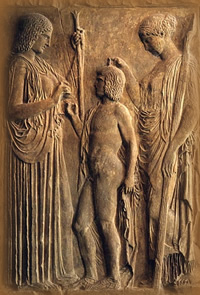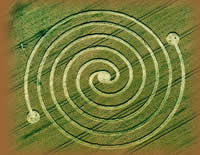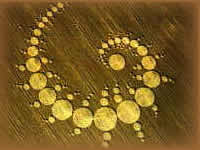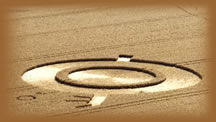
The goddess Demeter and her daughter Persephone, bestowing upon Triptolemus the mysteries and teaching him the agricultural arts.
Relief from Eleusis, Greece, 440 BCE
(Ovid, from Metamorphoses V)
Triptolemus was the son of the king of Eleusis, and one day, when he was tending his father’s cattle in the fields, he witnessed the abduction of Persephone by Hades, the god of the underworld. Persephone’s mother, the earth goddess Demeter, was nearly undone by her grief at her daughter’s disappearance. In her rage, she allowed the earth to fall barren and refused to restore it to its former abundance. In anguish she searched the world, and after years of hopeless wandering, she arrived in Eleusis. Only the boy Triptolemus knew her for what she was, as the goddess had grown unrecognisable during the years of her sorrow.
Triptolemus offered her solace with the news of what he had witnessed, and it was this clue that allowed the gods to arrange a compromise: Persephone would be restored to Demeter, but each winter she would return to Hades, where she ruled by his side as queen of the underworld.
In gratitude for his act of kindness, Demeter taught Triptolemus her mysteries, i.e. knowledge of the life-death-life cycle that is at the heart of our earthly existence. She then provided him with seed-corn, a plough, and her own serpent-drawn chariot, and sent him over the world to teach humans the art of agriculture.

West
Overton,
Wiltshire, England, 2002

nr Stonehenge,
Wiltshire, England, 2001

East
Overton,
Wiltshire, England, 2003
These
temporary temples in the fields are recognized as present-day
sacred sites by many. ...[The crop circles]
seem to act like portals or spiritual gateways just like the
ancient stone circles. They are heart opening and seem to speak
to us on a subconscious level.
...They help us connect to Spirit.
From “Temporary temples in the fields”, by Denni Clark
Crop circles are areas of standing crops that have been flattened in the shape of a circle or other, more complex, designs; they often materialise overnight and have been appearing in significant numbers since the 1970s.
Many people think crop circles are made by humans, and in the majority of cases this is undeniably true. But others argue that the speed with which some crop circles have appeared makes it impossible that humans are responsible. Alternatives to the explanation that crop circles are a human-made phenomenon are that 1) they occur naturally, the by-product of miniature tornados, 2) they are either signals to—or communications from—extraterrestrials, or that 3) they are enigmatic messages from the spirit of the earth itself.
Whatever their origin, there is abundant evidence that they have the potential of eliciting a spiritual reaction, a feeling of presence and, to some, the reassurance that the ancient spirits of the earth are very much alive. Humans have, from the dawn of time, projected the voice of their gods onto phenomena in the natural world, witness Moses falling to his knees in the wilderness before an apparently burning bush.